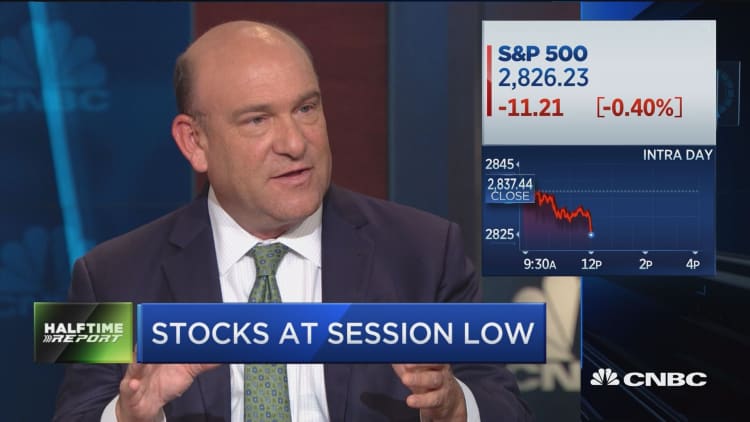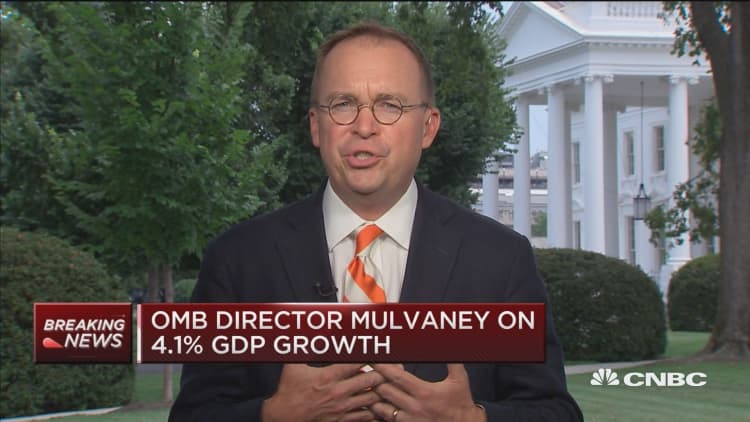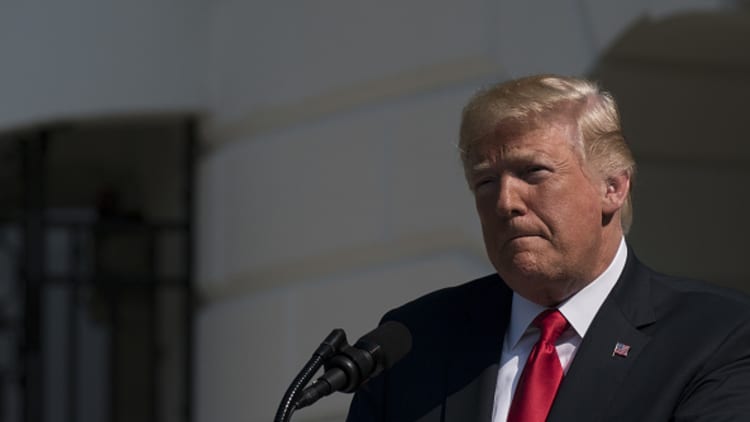
Second-quarter GDP was the best in nearly four years, at 4.1 percent, but market reaction was muted as the number missed some of the loftier 5 percent plus forecasts.
Market pros are also sifting through the government's revisions to the data, which resulted in changes in the last two first quarters and other adjustments.
The second-quarter growth figure was exactly in line with the consensus estimate of Thomson Reuters, but below some of the tracking estimates that were as high as 5.3 percent. Expectations were also elevated as President Donald Trump spoke about the number several times, including Thursday when he said he would be happy with a number with a 4 in front of it.
The 10-year Treasury yield, as high as 2.98 percent earlier, slipped to 2.95 percent and the 2-year was at 2.66 percent, off its morning high of 2.69 percent. Yields move opposite price. Stocks were lower in afternoon trading, after opening slightly higher.
"It's because it's not 5 percent, like some had hoped," said John Briggs, head of strategy at NatWest Markets. The number, however, is still strong. "Look at the average for the first two quarters, it's now 3.2 percent."
As expected, the consumer drove the economy in the second quarter, but at a much higher pace than projected, with consumption at 4 percent. That was about a point higher than forecast by economists, but first-quarter spending was revised down to just a half percent from 0.9 percent. Trade was also a big factor, as expected, contributing just more than 1 point.

"First of all it met expectations. The market was looking for low 4s. You got it. Now they're trying to sift through all the revisions. There were a lot of revisions. The change in the seasonals has clearly changed the distribution of growth over the course of the year. Now you have to redo your forecast and figure out what to do with the rest of the year," said Ward McCarthy, chief financial economist at Jefferies. "The economy is in good shape."
Inventories subtracted about a percent from growth, and some economists were quick to point out growth would have topped 5 percent if inventories were not so soft.
"Trade was great. Exports were up 9.3 percent. Imports only up a half percent. ... Net exports and inventories basically offset each other," McCarthy said.
Lee Ferridge, head of macro strategy for North America at State Street said that while the number was strong, it's probably the peak quarter for growth since such a high level of consumption is not sustainable nor is the export number, which may have been related to activity ahead of the implementation of Chinese tariffs on soybeans. Soybean exports were higher than normal in May.
"After all the hype, the market was looking for a 4.5 or above. When it came out at 4.1 , the market was a little disappointed," Ferridge said.
Chris Rupkey, chief financial economist at MUFG, said a first look at the revisions does not show any major change in trend.
"Real GDP 4.1 percent in the second quarter after 2.2 percent in the first quarter. If growth continues at 3.0 percent the next two quarters, then real GDP growth will indeed make it to 3.1 percent on a Q4/Q4 basis," he wrote.
Barclays, which had expected 5 percent growth, said the drag in inventories and the revision to first-quarter growth subtracted from the second-quarter number.
"Underpinning activity was solid growth in private consumption, which grew by 4.0 percent, and federal spending, which rose 3.5 percent on a sharp acceleration in defense spending," Barclays economists wrote. They noted that business fixed investment slowed to 5.4 percent from 8 percent in the first quarter.
The government revisions attempted to correct data that was viewed as unusually weak for the first quarter for a number of years. This year's first quarter was revised to 2.2 percent from 2.0 percent. For 2017, the first quarter was revised up to 1.8 percent, from 1.2 percent.
"You're redistributing growth. Now you have to figure out how that affects the rest of the year," said McCarthy.
WATCH: Experts debate whether 4% growth sustainable



